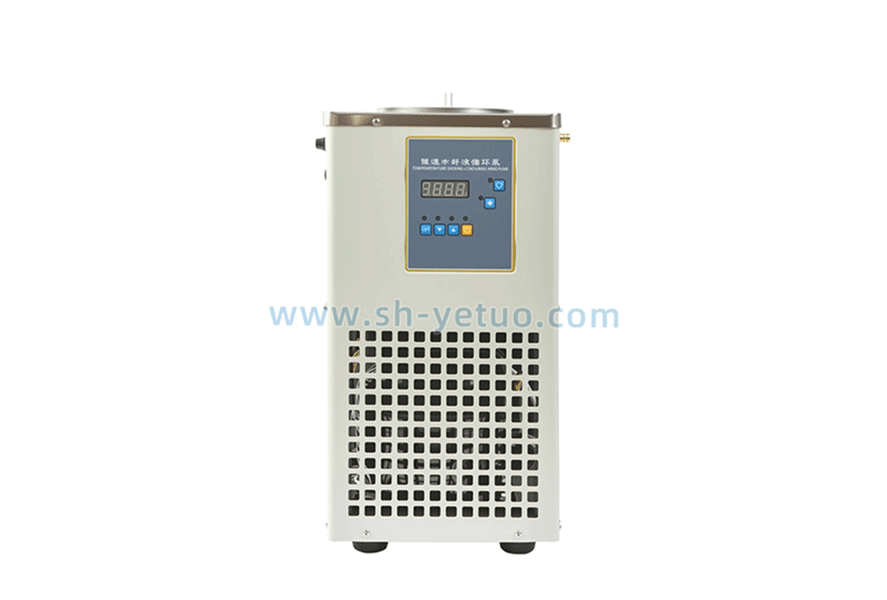As the core temperature control equipment in laboratory and industrial scenarios, the standardized use of Shanghai Yetuo low-temperature circulation pump not only directly affects the service life of the equipment, but also relates to the accuracy of experimental data and the safety of operators. To avoid equipment malfunctions, experimental deviations, or accidents caused by improper operation, the following usage precautions must be strictly followed, covering the entire process of "preparation before use, monitoring during operation, and maintenance after shutdown" to ensure stable and efficient operation of the equipment.
1、 Preparation before use: Build a solid foundation for the entire operation of AN
Before starting the low-temperature circulation pump, it is necessary to complete equipment inspection, medium selection, and environmental confirmation to eliminate potential risks and provide a complete prerequisite for subsequent operation.
Equipment appearance and connection inspection
Shou first observes whether the device body is damaged or corroded, and whether the touch screen, buttons, and other control components are intact. If cracks or exposed wiring are found on the shell, it is forbidden to start the device and professional personnel should be contacted for maintenance.
Check if the connection of the circulation pipeline is firm: Confirm that the interface between the inlet/outlet and the experimental device (such as reaction kettle, rotary evaporator) is not loose, use clamps or sealing tape to reinforce, and avoid medium leakage caused by pressure during operation; At the same time, check whether there is aging or cracking in the pipeline. If there are impurities remaining on the inner wall of the pipeline, rinse it with clean water or cleaning agent to prevent blockage and affect the flow rate.
Selection and filling of circulating medium
Suitable circulating media should be selected based on the experimental target temperature, and mixing different types of media is prohibited. If the target temperature is above 0 ℃, deionized water can be used to avoid scale formation; If the temperature is below 0 ℃, antifreeze medium (such as ethanol or ethylene glycol solution) should be used, and the concentration should be adjusted according to the low temperature range (for example, 50% ethanol solution can be used at -20 ℃). It is forbidden to directly use pure water to prevent freezing and expansion from damaging the water tank and pipeline.
When adding the medium, the liquid level must be strictly controlled: open the water tank cover and slowly inject the medium to between the "highest liquid level line" and the "lowest liquid level line", not lower than the lowest liquid level (to prevent wear and tear of the circulating pump due to idling), nor higher than the highest liquid level (to avoid short circuit caused by medium overflow during operation); After filling, the water tank cover should be tightly closed to prevent the medium from evaporating or impurities from falling in.
Confirmation of power supply and environment
Confirm that the power supply voltage is consistent with the rated voltage of the equipment (mainstream equipment is mostly 220V/50Hz, and some industrial models are 380V). If the voltage is unstable, a regulated power supply should be equipped; The power socket must have grounding function and the rated current must be greater than the maximum working current of the equipment (refer to the equipment nameplate parameters). It is prohibited to use a power strip in series to prevent overload and fire hazards.
The equipment should be placed in an environment that meets the requirements: the ambient temperature should be controlled between 5 ℃ -35 ℃, the relative humidity should not exceed 80%, and it should be avoided from direct sunlight, near heat sources (such as ovens and heaters), or humid areas (such as near sinks); At least 30cm of space should be reserved around the equipment to ensure smooth ventilation of the heat dissipation holes. It is prohibited to stack debris to block the heat dissipation.
2、 Monitoring during operation: Real time risk avoidance to ensure accurate experiments
After the device is started, it is necessary to continuously monitor the operating status, promptly handle abnormal situations, and ensure accurate temperature control and equipment safety.
Startup Operation Specification
When starting the device, it is necessary to follow the principle of "powering on the medium first, then powering on": after confirming that the medium has been filled and the pipeline connection is normal, turn on the power switch; After starting or not using for a long time, you need to first click the "self-test" function on the touch screen. After the system displays "no fault", set the target temperature and cycle parameters (such as flow rate and pressure). Do not skip self-test and start directly to prevent hidden faults from expanding.
The temperature setting should be gradual: if it is necessary to lower from room temperature to -30 ℃, the target temperature cannot be set at once. It should be cooled in stages (such as first dropping to -10 ℃, stabilizing for 10 minutes, then dropping to -20 ℃, and then dropping to -30 ℃) to avoid compressor damage caused by a sudden increase in refrigeration system load; After setting, observe the temperature curve changes. If the temperature drops slowly or stagnates, check whether the refrigeration system is abnormal and do not forcefully increase the refrigeration power.
Real time monitoring of operating parameters
Focus on changes in core parameters: Real time monitoring of current temperature, circulation flow rate, system pressure, and compressor status through the touch screen. During normal operation, temperature fluctuations should be within ± 0.1 ℃ to ± 0.5 ℃ (depending on equipment accuracy), flow rate should be consistent with the set value, and pressure should be between 0.1MPa-0.3MPa (if it exceeds 0.4MPa, the machine should be stopped to check if the pipeline is blocked); If there is a sudden rise or drop in temperature, zero flow rate, or abnormal increase in pressure, immediately press the "emergency stop" button, troubleshoot the problem, and then restart.
Prohibit unauthorized operations during operation: Do not disassemble pipelines or open water tank covers while the equipment is running to prevent damage from low-temperature media splashing; Do not arbitrarily change the set parameters (especially during critical stages of the experiment). If adjustments are needed, pause the experiment first and wait for the temperature to stabilize before making any changes; Do not insert hands or foreign objects into the interface of the circulation pipeline to avoid entanglement or injury.
Abnormal situation handling
If the device triggers an alarm (sound and light alarm or screen prompt), the cause should be investigated according to the alarm code: "Temperature alarm" may be due to insufficient medium, refrigeration system failure, or low target temperature (beyond the device range). The liquid level should be checked first, and then the refrigeration compressor should be confirmed to be started; Flow alarm "is often caused by pipeline blockage or circulation pump failure, which requires dismantling the pipeline to clean impurities or checking whether the pump body is stuck after shutdown; The "leakage alarm" should be immediately cut off from the power supply, and professional personnel should be contacted to test the circuit. It is prohibited to disassemble it by oneself.
In case of emergencies (such as medium leakage or equipment smoking), the main power supply should be immediately cut off, personnel on site should be evacuated, and the leaked medium should be cleaned up after the equipment cools down (if it is flammable medium such as ethanol, it should be wiped clean with a dry cloth, and rinsing with water is prohibited), and the manufacturer's after-sales service should be contacted. Unauthorized repairs are not allowed.
3、 Maintenance after shutdown: Extend equipment lifespan and ensure reliable next use
After the experiment, it is necessary to standardize the shutdown and maintenance to lay the foundation for the long-term stable operation of the equipment.
Shutdown operation steps
The principle of "heating up first, then stopping" should be followed: if the experimental temperature is below 0 ℃, it cannot be stopped directly. The target temperature should be set to room temperature (around 25 ℃) first. After the circulating medium temperature rises to above 5 ℃, click the "stop" button and then cut off the power to prevent the low-temperature medium from freezing and damaging the pipeline and water tank.
After shutdown, it is necessary to promptly handle the circulating medium: if it is still needed in the short term (within 1 week), the medium can be kept in the water tank, but the water tank cover should be tightly closed to avoid volatilization; If not used for a long time (more than one month), all media should be drained: open the drain valve at the bottom of the water tank and drain the media into a container for use (flammable media such as ethanol should be stored separately and cannot be dumped at will), then rinse the water tank and pipeline 2-3 times with clean water to remove residual moisture and prevent pipeline corrosion.
Equipment cleaning and maintenance
Cleaning the outside of the equipment: Use a dry cloth to wipe the dust on the surface of the machine body. If there is any residual medium (such as ethanol or solution), use a damp cloth dipped in neutral cleaning agent (such as detergent) to wipe it, and then dry it with a dry cloth. Do not use strong acid, strong alkali cleaning agents or steel wire balls to prevent scratching the shell or corrosion of the surface coating.
Regular maintenance of core components: check the circulating pump every 3 months: remove the pump body protective cover, clean impurities on the impeller, and add lubricating oil (refer to the equipment manual model); Check the refrigeration system every 6 months: check for leaks in the compressor piping (use soapy water to apply to the interface and observe for bubbles), clean the dust on the heat sink (use a soft brush or compressed air to blow it off); Please have professional personnel conduct a comprehensive inspection once a year, including temperature control sensor calibration, electrical circuit testing, etc.
Storage and Recording
Equipment storage must meet environmental requirements: when not in use for a long time, it should be placed in a dry and ventilated room, avoiding direct sunlight and moisture; If the storage environment temperature is below 0 ℃, it is necessary to ensure that there is no residual moisture in the storage area to prevent freezing and damage; Cover the surface of the device with dust-proof cloth to prevent dust accumulation.
Establish a usage record file: Record the running time, experimental temperature, abnormal situations, and handling methods of the equipment after each use, in order to trace the equipment status, timely discover potential problems (such as frequent alarms that may indicate component aging), and provide a basis for subsequent maintenance.
4、 Additional precautions for special scenarios
Multi device linkage use
If multiple low-temperature circulation pumps are linked for control (such as industrial production lines), it is necessary to ensure that the parameters of each device are matched and connected uniformly through a communication interface (RS485). It is prohibited to adjust the parameters of a single device separately to prevent temperature imbalance in the system; During linkage operation, additional monitoring of total current and voltage is required to avoid exceeding the power supply load.
Use of corrosive media
If corrosive media (such as acidic or alkaline solutions) are required for the experiment, a corrosion-resistant low-temperature circulation pump (made of PTFE or 316L stainless steel for the pipeline and water tank) should be selected. The use of ordinary models is prohibited; Immediately discharge the medium after use, rinse the water tank and pipelines with plenty of clean water, and then neutralize the residue with a neutral solution (such as sodium bicarbonate solution) to prevent corrosion of the components.
Following the above usage precautions can not only maximize the temperature control of the low-temperature circulation pump, ensure reliable experimental data, but also extend the service life of the equipment, avoid all risks, and keep the equipment in a stable and efficient operating state, providing solid support for scientific research and production.


 Alibaba Store
Alibaba Store Tmall Store
Tmall Store Jingdong Sstore
Jingdong Sstore







